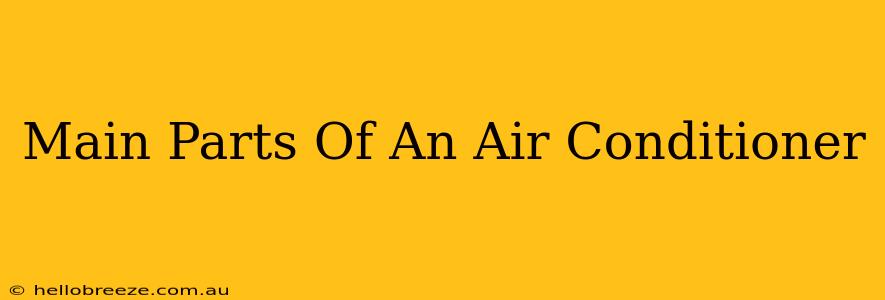Understanding the main components of your air conditioner is crucial for both its maintenance and troubleshooting. This guide breaks down the essential parts, explaining their functions and how they work together to keep you cool. Knowing these parts can help you better understand your AC unit's needs and prevent costly repairs.
The Core Components of Your Air Conditioning System
An air conditioner, whether a window unit, split system, or central AC, comprises several key components. Let's explore each one:
1. Evaporator Coil
The evaporator coil is located inside your home. Its primary function is to absorb heat from the indoor air. Refrigerant, in its low-pressure, low-temperature state, flows through the coil. As the refrigerant absorbs heat from the air blowing across it, it evaporates, cooling the air. This cooled air is then circulated throughout your home by the blower fan. A dirty evaporator coil reduces efficiency, so regular cleaning is important.
2. Condenser Coil
The condenser coil is the outdoor unit's main working part. Here, the refrigerant, now a hot gas, releases heat into the outside air. This is why your outdoor unit feels hot to the touch when it's running. A fan on the condenser unit helps dissipate this heat more effectively. Like the evaporator coil, a clean condenser coil is essential for optimal performance. Blocked condenser coils significantly reduce cooling capacity.
3. Compressor
The heart of the air conditioning system, the compressor, increases the pressure and temperature of the refrigerant. This is a vital step in the refrigeration cycle because it allows the refrigerant to release its absorbed heat efficiently in the condenser coil. Compressor failure is a serious issue and often requires professional repair.
4. Expansion Valve (or Metering Device)
The expansion valve, also known as a metering device, controls the flow of refrigerant from the high-pressure side to the low-pressure side of the system. It regulates the refrigerant's pressure and temperature to ensure proper cooling. A malfunctioning expansion valve can lead to inefficient cooling or even damage to other components.
5. Blower Fan (Indoor Unit)
The blower fan is responsible for circulating the cooled air from the evaporator coil throughout your home. Its speed can often be adjusted to control airflow and energy consumption. A faulty blower motor can result in uneven cooling or no cooling at all.
6. Refrigerant
Refrigerant is the substance that absorbs and releases heat, enabling the cooling process. It's a closed-loop system, meaning it circulates continuously within the AC unit. The type of refrigerant used is important for environmental reasons. Newer systems use refrigerants with a lower global warming potential. Refrigerant leaks require professional attention.
Maintaining Your Air Conditioner for Optimal Performance
Regular maintenance of your air conditioner's components is vital for extending its lifespan and ensuring efficient operation. This includes:
- Cleaning the coils: Regularly clean both the evaporator and condenser coils to remove dirt and debris.
- Checking refrigerant levels: Low refrigerant levels can drastically reduce cooling capacity. Call a professional if you suspect a leak.
- Inspecting the blower fan: Ensure the fan blades are clean and the motor is functioning correctly.
- Changing air filters: Regularly replace or clean air filters to improve airflow and prevent dust buildup.
By understanding these main parts and performing routine maintenance, you can keep your air conditioner running smoothly and efficiently throughout the summer months. If you experience any problems, it’s always best to consult with a qualified HVAC technician.

